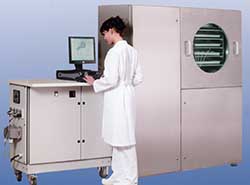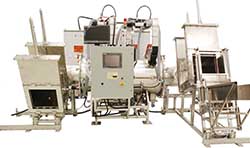Getting a Fix on Freeze-Drying
PROCESSING
Freeze-drying is an underused and under appreciated technology that could be considered the gold standard for dehydration of foods and pharmaceuticals. Compared to other dehydration technologies, it may be more expensive, but it produces materials that are difficult to duplicate in any other way.
Freeze-drying relies on sublimation of ice directly to vapor without passing through a liquid phase. This requires maintaining conditions that are dictated by the phase diagram for water. Sublimation occurs when the water vapor pressure is less than 4.6 mm Hg and the temperature is below 0°C. Frequently the pressure requirement is achieved by maintaining a low total pressure, a vacuum, but that is not strictly necessary and, in fact, can be counterproductive.
 As is true for many forms of dehydration, freeze-drying rate is often controlled by internal heat transfer. Any form of drying involves simultaneous heat and mass transfer. Resistances to heat and mass transfer occur both internally to the food or other material and externally. In the case of freeze-drying, heat may be applied through the dried layer or through the frozen layer. An example of the latter case is when frozen liquids are dried in vials or trays that are heated from below.
As is true for many forms of dehydration, freeze-drying rate is often controlled by internal heat transfer. Any form of drying involves simultaneous heat and mass transfer. Resistances to heat and mass transfer occur both internally to the food or other material and externally. In the case of freeze-drying, heat may be applied through the dried layer or through the frozen layer. An example of the latter case is when frozen liquids are dried in vials or trays that are heated from below.
The thermal conductivity of the frozen layer is normally much higher than that of the dried layer, especially at low total pressure. As pressure increases, the residual gas in the porous dried layer increases the thermal conductivity, so the heat transfer rate increases as pressure increases.
On the other hand, the diffusivity of water vapor through the porous dried layer decreases as pressure increases. Thus, there can be an optimum pressure for maximizing the rate in freeze-drying. This is not widely appreciated, so common practice is to maintain a very low pressure. The improvement in thermal conductivity is highest when the residual gas has a low molecular weight, such as hydrogen or helium. Usually, the pressure is adjusted by allowing a small leak of air through a needle valve. In that case, the optimum pressure may be lower than if a light gas were used.
Other factors that affect freeze-drying rates include how the material is frozen and how heat is applied. A rapid freezing rate may create relatively small pores because the water freezes into small ice crystals. Slow freezing has the opposite effect. As water is frozen, the residual dissolved solids become concentrated and increase the viscosity of the unfrozen phase. During drying, the dry phase may warm up and flow, leading to collapse and restriction of vapor flow.
Often freeze-driers are equipped with platens or hollow trays that can be heated or cooled. If the platens are used for freezing, the rate may be slow because contact is not always perfect. Better, usually, is to freeze externally to the drier and then rapidly transfer to the drying chamber.
In the same way, heating through the platens may be imperfect because of irregular contact. Excessive heating can cause melting and collapse. A better practice is to have the product held off the platens and heated by infrared radiation. This allows the heating temperature to be increased substantially since infrared radiation is proportional to the difference of absolute temperatures raised to the fourth power. Some commercial driers, such as those offered by GEA (www.GEA.com), transport trays of frozen food between heated platens.
Maintaining Low Water Vapor Pressure
While water vapor transport is rarely the controlling phenomenon, conditions must be maintained that ensure that is true. Specifically, the water vapor pressure at the subliming interface must be higher than that at some sink for water vapor. One approach is simply to exhaust the vapor using a mechanical vacuum pump. An ejector or educator cannot achieve a low enough vapor pressure by itself though they are sometimes used in series with a pump.
Another approach is to freeze the water vapor, which requires maintaining a surface well below 0°C. As ice builds up on such a surface, a temperature gradient is established in the ice layer, which reduces the freezing rate and can start to limit the freeze-drying rate. One approach, invented by a colleague of mine in graduate school, was to freeze water vapor onto a flowing layer of very cold immiscible oil, which was then filtered to remove the ice.
The approach used by GEA and other commercial freeze-driers is to isolate condensing surfaces with large valves (large because the vapor volume is large at low pressure) and periodically melt the ice from the condenser surface, much like defrosting refrigeration evaporator coils.
Many pharmaceutical and biological materials are freeze-dried in vials with rubber stoppers. The stoppers are loosely fitted in the tops of the glass vials, which creates an additional resistance to vapor flow. Consequently, freeze-drying rates of such materials often are very low and drying occurs over several days. The value of these materials is so high that such a lengthy process is acceptable. At completion of drying, the platens are moved down to tighten the stoppers.
--- PAGE BREAK ---
Determining when drying is complete is another challenge. For a given material and set conditions, the rate can be determined by repeated weighing, often using a built-in scale in the drier. The temperature of the material will rise once all the moisture is removed, signaling the end of drying, so measuring the internal temperature also works. Measuring the load on the ice condenser would theoretically work, but may not be sensitive enough.
 Competing with Freeze-Drying
Competing with Freeze-Drying
EnWave Corp. (www.enwave.net) is a Canadian firm that offers a microwave heated vacuum dryer, Radiant Energy Vacuum (REV), which the company asserts yields products with properties comparable to those that are freeze-dried. Since microwave energy selectively heats where the moisture is, it overcomes the heat transfer rate limitation of other drying methods. Drying under vacuum reduces the evaporation temperature of water and also reduces any mass transfer resistance. There are methods of continuously introducing and removing materials to and from a vacuum chamber, but most vacuum drying is conducted in batches.
Reducing the temperature and expanding residual gas helps to reduce collapse and the development of case hardening. Case hardening occurs when soluble solids migrate with moisture to the surface of a piece and then are deposited. Case hardening and collapse retard rehydration.
Another unique drier was encountered in Haiti, drying mango slices and other tropical fruits. It was supplied by a French firm and was constructed from a shipping container. There was no external source of heat. Instead, circulating air was continuously dehumidified using a refrigerated coil. The heat of evaporation was supplied from ambient air, so drying rate was very slow. However, it was also very gentle, so the fruit slices maintained a light color and did not shrink or collapse.
The water that was condensed from the circulating air was very pure, with a slight hint of fruit flavor. In Haiti, such pure water has value. The dried fruit is high quality and offers an outlet for fruit that otherwise is wasted. One objective of the sponsor of the project, Catholic Relief Services, is to convince the Haitians that mango trees are more valuable for their fruit than as firewood.
For liquids, spray-dying often provides a perfectly adequate dried product. Freeze-drying was considered a great advance for producing instant coffee because it retained volatile flavors at the low drying temperature. However, in reality, much instant soluble coffee is used in beverages where sweeteners and dairy ingredients are added, so spray-drying is still used because it is less expensive than freeze-drying and the results are sufficient.
Spray-drying atomizes concentrated liquids into small droplets and injects these into hot air or inert gas. The hot air may be concurrent with the droplets, countercurrent, or mixed flow. Dried particles are separated in cyclones and bag filters and the air or gas may be recycled or exhausted. One concern with spray-drying is buildup of damp droplets on the walls of the drier. Another concern is loss of particles from the recovery system. In addition to being a yield loss, such losses could be an air emissions issue.
Innovations in drying are difficult to achieve because the fundamental energy requirements are fixed, the properties of candidate materials are highly variable, and the various determinants of rates are complex. Freeze-drying is almost a gold standard of dehydration, but can be expensive. Some novel applications, in which conventional cost concerns are almost irrelevant, include salvaging of waterlogged books and other paper objects from library fires and preservation of biological collections, such as intact animal specimens. There are large vacuum chambers in almost continuous use recovering frozen books that were damaged by water in fires. The books are promptly frozen to prevent mold from invading and then freeze-dried as availability of the driers permits. Whole animals up to large lions in size are frozen and then dried as an alternative to taxidermy.
 J. Peter Clark, Ph.D., CFS,
J. Peter Clark, Ph.D., CFS,
Contributing Editor,
Consultant to the Process Industries, Oak Park, Ill.
[email protected]
